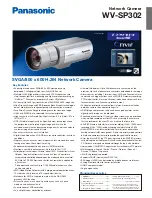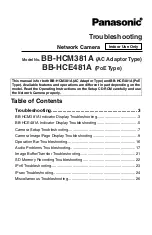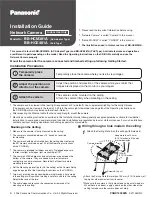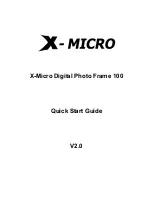
56
Ⅳ. ADJUSTMENT
3. CCD GAIN
A. Purpose
The ideal CCD saturation level is 1VPP. But, the real CCD saturation level is under 1 VPP (500 ~ 550 mVpp).
To change the 500 ~ 550 mVpp to 1 Vpp level, set the minimum Analog gain.
This adjustment is for minimizing the gabs of CCD saturation level of each camera by adjusting the Analog gain.
B. Behavior
As for the NV10 uses two kinds of ND filter, there are two type of adjustments.
[Description of the algorithm]
①
Check the brightness level in the Liveview mode.
②
Check the difference between the target and checked brightness.
And then set the default CCD gain.
③
Check the availability of the brightness value.
④
Depending on the result, decide OK or NG.
[Standards for the Adjustment]
- Specification of the tools : Light source that can block the external light source
- Color temperature: 3200K ± 50
- Brightness: LV 8.2±0.1 ( ±0.05 recommended)
C. Spec (Standard for checking defect)
- From the PV-2 steps, the adjustment actualizes. The followings are temporary standard.
①
9181 - 341 < Average brightness of the test < 9181 + 341
②
170 < CCD gain < 265
D. Procedure
①
Save the adjust103.txt and adjust_t files on the Root directory of the SD card and insert the card.
Summary of Contents for VLUU NV10
Page 1: ......
Page 14: ...14 Ⅱ INSTALLATION FAQ 4 Install the Digimax Master in order ...
Page 48: ...48 Ⅳ ADJUSTMENT 6 The Upgrade will start with displaying the following message ...
Page 55: ...55 Ⅳ ADJUSTMENT Open the file with the Memo pad ...
Page 75: ...75 Ⅳ ADJUSTMENT Open the file with the Memo pad ...
Page 82: ...82 Ⅳ ADJUSTMENT Open the file with the Memo pad ...
Page 105: ...Ⅴ PATTERN DIAGRAM 105 1 PARTS ARRANGEMENT FOR EACH PCB ASS Y 1 MAIN_TOP ...
Page 106: ...106 Ⅴ PATTERN DIAGRAM 2 MAIN_BOTTOM ...
Page 107: ...107 Ⅴ PATTERN DIAGRAM 3 STROBO_TOP ...
Page 108: ...108 Ⅴ PATTERN DIAGRAM 4 STROBO_BOTTOM ...
Page 109: ...Ⅵ CIRCUIT DIAGRAM 109 1 MAIN BLOCK DIAGRAM ...
Page 110: ...110 Ⅵ CIRCUIT DIAGRAM 2 MAIN_AUDIO_VIDEO ...
Page 111: ...111 Ⅵ CIRCUIT DIAGRAM 3 MAIN_DSP ...
Page 112: ...112 Ⅵ CIRCUIT DIAGRAM 4 MAIN_PANASONIC 10M_NN12068A ...
Page 113: ...113 Ⅵ CIRCUIT DIAGRAM 5 MAIN_MEMORY DDR FLASH ...
Page 114: ...114 Ⅵ CIRCUIT DIAGRAM 6 MAIN_PIC_MICOM ...
Page 115: ...115 Ⅵ CIRCUIT DIAGRAM 7 MAIN_MOTOR IC ...
Page 116: ...116 Ⅵ CIRCUIT DIAGRAM 8 MAIN_POWER ...
Page 117: ...117 Ⅵ CIRCUIT DIAGRAM 9 MAIN_CRADLE ...
Page 118: ...118 Ⅵ CIRCUIT DIAGRAM 10 MAIN_LCD ...
Page 119: ...119 Ⅵ CIRCUIT DIAGRAM 11 MAIN_TOP KEY ...
Page 120: ...120 Ⅵ CIRCUIT DIAGRAM 12 TOUCH KEY ...
Page 121: ...121 Ⅵ CIRCUIT DIAGRAM 13 STROBO ...
Page 122: ...122 Ⅵ CIRCUIT DIAGRAM 14 24PIN CRADLE CONNECTOR ...
Page 123: ...123 Ⅵ CIRCUIT DIAGRAM 15 MAIN_STR CONNECTOR ...
Page 124: ...124 Ⅵ CIRCUIT DIAGRAM 16 SUB BLOCK DIAGRAM ...
Page 125: ...125 Ⅵ CIRCUIT DIAGRAM 17 SUB_FPCB TO MAIN ...
Page 126: ...126 Ⅵ CIRCUIT DIAGRAM 18 CASIO_LCD ...
Page 127: ...127 Ⅵ CIRCUIT DIAGRAM 19 TELE_WIDE ...
Page 128: ...128 Ⅵ CIRCUIT DIAGRAM 20 TOUCH_PAD ...
Page 129: ...129 Ⅵ CIRCUIT DIAGRAM 21 TACT_FPCB ...
Page 130: ...130 Ⅵ CIRCUIT DIAGRAM 22 TOP POWER MODE KEY ...
Page 131: ...131 Ⅵ CIRCUIT DIAGRAM 23 BLOCK DIAGRAM ...
Page 141: ...141 Ⅶ SERVICE INFORMATION 22 Disassemble the Barrel ASSY 3 Disassemble the LCD PCB ...
Page 144: ...144 Ⅶ SERVICE INFORMATION 4 Assemble two screws 5 Place the LCD PCB under the Barrel ...
Page 151: ...151 Ⅶ SERVICE INFORMATION 24 Assemble 4 screws 25 Assemble 2 screws 26 Assemble 4 screws ...
Page 157: ...157 Ⅶ SERVICE INFORMATION 16 Remove a screw 17 Disassemble the SHUTTER ASSY ...
















































